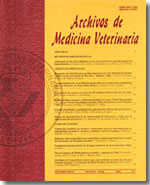Risk factors for the presentation of undesired behaviours in sport horses in Chile
Main Article Content
Abstract
Behaviour alterations are considered as cause and symptom of poor animal welfare. Generally they have been associated to suboptimal husbandry practices and intrinsic factors of horses. The aim of this study was to indentify risk factors for the presentation of behaviour alterations in sport horses. The information of 1,529 equines was compiled from three databases, the individuals were classified in groups according to the type of behaviour in "locomotor" and "oral". Environmental and intrinsic conditions were evaluated as possible risk factors for the presentation of oral behavioural alterations through a multiple logistic regression model; a significance level of P < 0.05 was considered. A total of 188 individuals with behavioural alterations were registered, and thirteen of them presented more than one alteration. A total of 90 locomotor and 111 oral undesired behaviours were registered; the most frequent undesired behaviours were box-walking and cribbiting/wind-sucking for each group respectively. In the case of locomotor behaviours no risk factors statistically significant were found, however a forage percentage ≥ 60% in the ration was identified as a protective factor, as was belonging to the Chilean breed. On the other hand, for the oral behaviours, a forage percentage ≥ 60% was identified as a statistically significant risk factor, and the Thoroughbred breed was identified as protective factor in the logistic regression. Some management factors and intrinsic characteristics of the animal may increase or decrease the presentation of these behaviours in sport horses, these factors should be considered when designing an equine production system in order to maintain their welfare.

